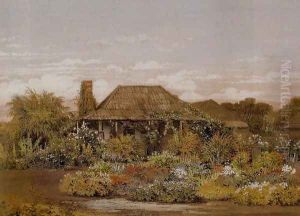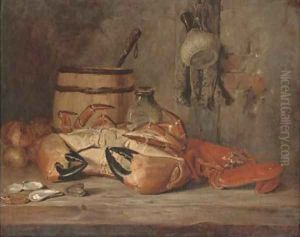Edward La Trobe Bateman Paintings
Edward La Trobe Bateman was a British artist and designer known for his contributions to the Pre-Raphaelite movement and his work in Australia. Born in 1816, Bateman's early life and training are not well documented, but he is often associated with the Pre-Raphaelite Brotherhood, an influential group of English painters, poets, and critics founded in 1848. The Brotherhood aimed to reform art by rejecting what it considered the mechanistic approach first adopted by Mannerist artists who succeeded Raphael and Michelangelo. They believed in a return to the abundant detail, intense colours, and complex compositions of Quattrocento Italian art.
Bateman's connection with the Pre-Raphaelites came through his friendship with key figures in the movement, such as John Ruskin and Dante Gabriel Rossetti. While he did not achieve the same level of fame as some of his contemporaries, Bateman's work was nonetheless respected within the artistic community. His contributions were primarily in the realm of botanical illustration and design, where his meticulous attention to detail and his reverence for nature reflected the Pre-Raphaelite ethos.
In the mid-1850s, Bateman emigrated to Australia, settling in Victoria. His time in Australia proved to be significant in his career. He was involved in various design and illustration projects, including the creation of landscapes and drawings of native plants. His work from this period shows a keen observation of the natural world and a delicate touch in rendering the Australian landscape and flora. Bateman's designs were instrumental in the development of early Australian botanical and landscape illustration, and his works are an important part of the country's visual history.
Bateman returned to England in the 1860s but continued to work and exhibit his art. His contributions during this period included book illustrations and designs for stained glass. Despite his artistic output, Bateman remained a somewhat elusive figure in art history, with fewer personal details known about him compared to his Pre-Raphaelite contemporaries.
Edward La Trobe Bateman passed away in 1897, leaving behind a legacy that, while not as widely recognized as that of some of his peers, is valued for its unique contribution to the art and design of the 19th century. Today, his works can be found in various collections, including those in Australia, where his impact on the visual documentation of the country's natural history is most pronounced.

